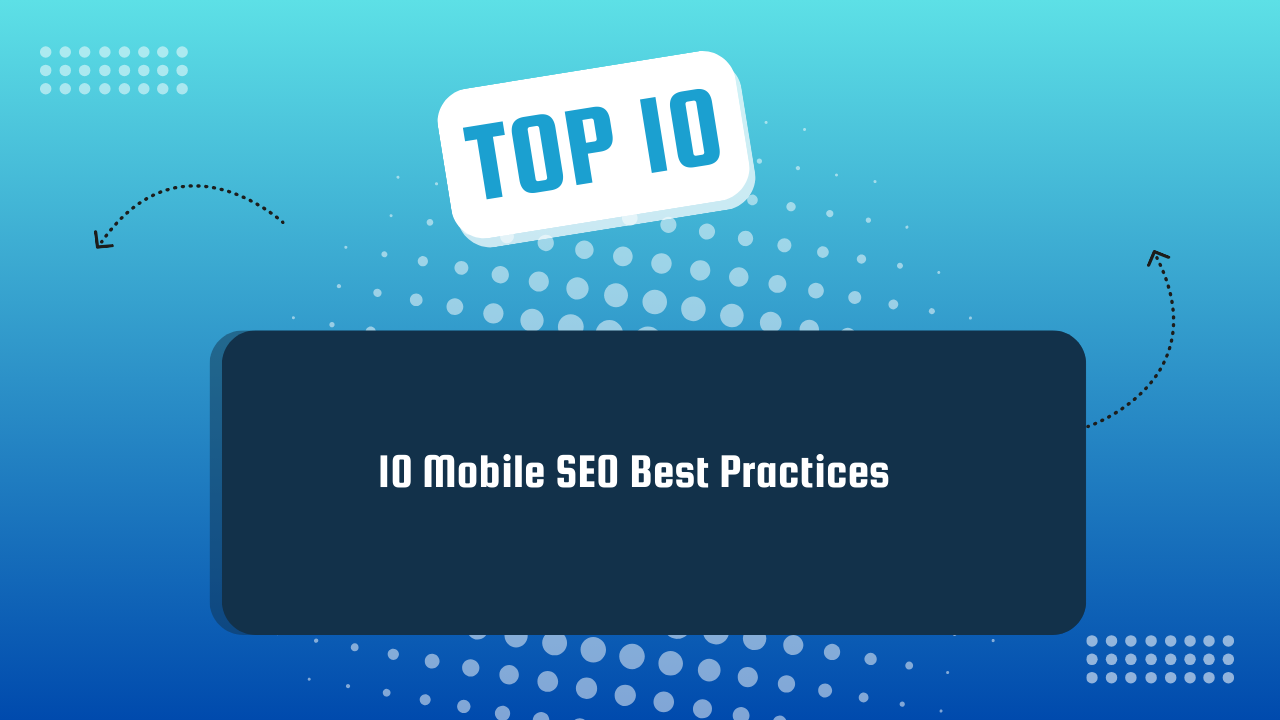In the age of mobile-first indexing, optimizing your website for mobile devices is no longer an option – it's a necessity. With more than half of all web traffic now coming from mobile devices, businesses that fail to prioritize mobile SEO risk being left behind by their competitors. In this article, we'll explore 10 essential mobile SEO best practices that can help you improve your website's visibility, user experience, and search engine rankings in the mobile-first era.
1. Implement Responsive Web Design (RWD)
Responsive web design (RWD) is the foundation of mobile SEO. It ensures that your website's layout and content adapt seamlessly to different screen sizes and devices, providing a consistent and user-friendly experience across all platforms.
Example: Take a look at how the website for the popular e-commerce platform Shopify adapts its layout and content for different screen sizes. The desktop version features a three-column layout with large images and detailed product descriptions, while the mobile version optimizes for smaller screens by displaying a single-column layout with more compact content and larger touch targets.
Guide: To implement responsive web design, you can use CSS media queries and flexible grids to create a fluid and adaptable layout. Additionally, consider using mobile-first design principles, where you start by designing for the smallest screen size and progressively enhance the experience for larger displays.
2. Prioritize Page Speed
Page speed is a critical ranking factor for mobile SEO. Slow-loading websites frustrate users and negatively impact engagement, conversion rates, and search rankings. Optimizing your website's page speed should be a top priority.
Example: Google's PageSpeed Insights tool is an excellent resource for analyzing your website's performance on both desktop and mobile devices. It provides a score based on various factors, including server response time, image optimization, and efficient rendering. The tool also offers specific recommendations for improving page speed, such as leveraging browser caching and minifying CSS and JavaScript files.
Guide: To improve page speed, start by conducting a website speed audit using tools like Google PageSpeed Insights, WebPageTest, or Lighthouse. Then, follow best practices like optimizing images (compression, lazy loading, WebP format), minimizing HTTP requests, leveraging browser caching, and using a content delivery network (CDN) to serve static assets.
3. Create Mobile-Friendly Content
Optimizing your content for mobile users is essential. Focus on creating concise, scannable, and easily digestible information that works well on smaller screens.
Example: The popular news website CNN has a dedicated mobile site (m.cnn.com) that optimizes content for mobile devices. Articles feature shorter paragraphs, larger font sizes, and clear headings, making them easier to read on smaller screens. Additionally, the site prioritizes the most important information, such as breaking news, at the top of the page.
Guide: When creating mobile-friendly content, use clear and descriptive headings, shorter paragraphs, bullet points, and concise sentences. Consider using multimedia elements like images, videos, and infographics to break up text and make your content more engaging. Additionally, prioritize the most important information at the top of the page and use progressive disclosure to reveal additional details as needed.
4. Optimize Images and Media
Large, unoptimized images and media files can significantly impact page load times on mobile devices. Compressing images, using appropriate file formats, and implementing lazy loading techniques are essential for improving performance.
Example: The popular e-commerce platform Etsy does an excellent job of optimizing images for mobile devices. They use compressed image formats (like WebP) and lazy loading to ensure that only the images visible on the screen are loaded initially, minimizing data usage and improving page load times.
Guide: To optimize images and media for mobile devices, start by compressing files using tools like TinyPNG or Squoosh.app. Use the WebP image format, which provides better compression without sacrificing quality. Implement lazy loading to defer the loading of offscreen images until they are needed. Additionally, consider using responsive images and providing multiple image sizes to ensure the appropriate file is served based on the device's screen size and resolution.
5. Leverage Accelerated Mobile Pages (AMP)
Accelerated Mobile Pages (AMP) is an open-source initiative that enables the creation of lightweight, fast-loading web pages specifically designed for mobile devices. Implementing AMP can significantly improve page load times and user engagement, leading to better search rankings and visibility.
Example: Many popular news and media websites, such as The Washington Post, have adopted AMP to provide a fast and streamlined mobile experience. AMP pages load almost instantly, with a minimal, distraction-free design that prioritizes content consumption.
Guide: To implement AMP, create a separate AMP version of your website's pages using the AMP HTML framework. Follow the guidelines for building valid AMP pages, including using approved components, optimizing resource loading, and adhering to AMP's performance best practices. Once your AMP pages are ready, submit them to Google for indexing and validation.
READ ALSO:
6. Focus on Mobile Usability
Ensuring that your website's design and navigation are optimized for mobile devices is crucial. Use large, clickable buttons and links, simplify forms, and minimize the need for pinching and zooming, which can enhance the overall mobile user experience.
Example: The popular travel website TripAdvisor has a mobile-friendly design that features large, easy-to-tap buttons and navigation elements, making it simple for users to browse and interact with the site on their mobile devices.
Guide: To prioritize mobile usability, start by conducting usability testing on various mobile devices and screen sizes. Ensure that touch targets (buttons, links, etc.) are large enough for comfortable tapping, with a recommended minimum of 48x48 pixels. Simplify forms by minimizing the number of required fields and providing clear error messages. Additionally, avoid horizontal scrolling and pinching/zooming by using a responsive design that adapts to different screen sizes.
7. Implement Mobile-Friendly Pop-ups and Interstitials
Avoid intrusive pop-ups and interstitials that disrupt the user experience on mobile devices. If you must use them, ensure they are easily dismissible and do not obscure content.
Example: Google has provided guidelines for mobile-friendly interstitials, which recommend using small banners or modals that occupy a reasonable amount of screen space and can be easily dismissed by users. Websites that comply with these guidelines are less likely to be penalized in search rankings.
Guide: When using pop-ups or interstitials on mobile devices, follow Google's guidelines for mobile-friendly interstitials. Ensure that any prompts or modals occupy no more than 30% of the screen space, can be easily dismissed, and do not obscure the main content. Additionally, consider using alternative approaches, such as inline banners or slide-in notifications, to provide a less disruptive user experience.
8. Implement Mobile Sitemaps
Creating dedicated mobile sitemaps can help search engines better understand and index your website's mobile content, improving visibility and ranking potential.
Example: Google's Search Console provides tools for creating and submitting mobile sitemaps. These sitemaps should include the URLs of your mobile-friendly pages, along with relevant metadata and information about alternate desktop versions, if applicable.
Guide: To create a mobile sitemap, use the standard XML sitemap format and include the URLs of all your mobile-friendly pages. If you have separate desktop and mobile versions of your site, use the `` element to indicate the relationship between them. Once your mobile sitemap is ready, submit it to Google Search Console for indexing and validation.
9. Optimize for Voice Search
As voice-based assistants and search become more prevalent, optimizing your content for natural language queries and conversational search patterns is crucial.
Example: When you use voice search to ask a question like "What are the best Italian restaurants near me?", Google provides a featured snippet with a direct answer and a list of local Italian restaurants. This type of result is optimized for voice search and aims to provide a concise, direct answer to the user's query.
Guide: To optimize for voice search, focus on creating content that answers common questions and queries in a conversational and natural language style. Use long-tail keyword phrases and question-based structures to make your content more discoverable for voice search. Additionally, leverage structured data and schema markup to help search engines better understand the context and entities within your content.
10. Stay Up-to-Date with Mobile SEO Trends and Updates
The mobile landscape is constantly evolving, with new technologies, devices, and search engine algorithms emerging regularly. Stay informed about the latest mobile SEO trends, best practices, and algorithm updates to ensure your optimization strategies remain effective.
Example: Google's algorithm updates, such as the Mobile-Friendly Update (2015) and the Mobile-First Indexing rollout (2018-2021), have had a significant impact on mobile SEO. Businesses that stayed ahead of these changes and adapted their optimization strategies accordingly were better positioned to maintain and improve their search rankings.
Guide: Follow authoritative sources and industry experts to stay up-to-date with the latest mobile SEO trends and best practices. Subscribe to newsletters, blogs, and podcasts that cover mobile search, user experience, and search engine optimization. Additionally, monitor official announcements and updates from major search engines like Google and Bing to understand how their algorithms and ranking factors are evolving.
Conclusion
In the mobile-first era, optimizing your website for mobile devices is no longer a choice – it's a necessity. By implementing these 10 mobile SEO best practices, you can improve your website's visibility, user experience, and search engine rankings, ensuring that your business stays competitive in a mobile-dominated digital landscape. Remember, mobile SEO is an ongoing process that requires continuous monitoring, testing, and adaptation to evolving trends and technologies. Stay vigilant, embrace mobile optimization as a core part of your digital strategy, and position your business for success in the mobile-first world.





